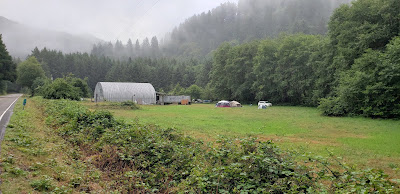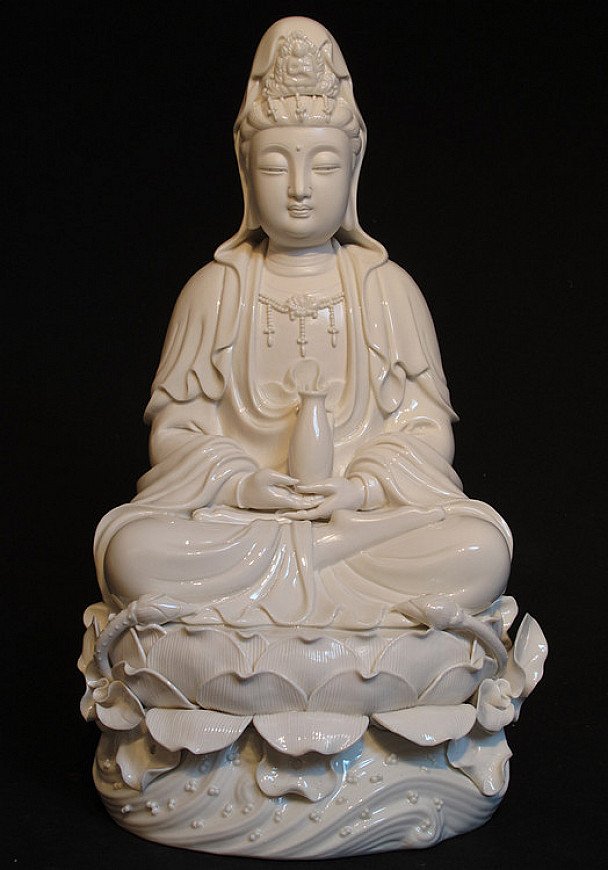Buddha Root Farm And Understanding Mahayana Buddhism

"You have stumbled upon the 5 schools of Chinese Mahayana Buddhism, in the lineage of Master Hua." After the first day of retreat, where I was constantly asking questions, Rev Heng Sure said this to me as a precursor to lots more sharing in the coming days. These were very meaningful days in my life.
I recently returned from my first meditation retreat that was not in the SN Goenka tradition. Lots of learnings from this and I thought it would support me to process through writing. The retreat was in the tradition of Rev Heng Sure, who so many have been inspired by in our community. The retreat was their yearly 'Buddha Root Farm' retreat in rural Oregon (the picture above is the path to our campsite). Several folks in our ecosystem have attended before (including my partner!) but it was my first time.
 Master Hua lecturing in 1975
Master Hua lecturing in 1975
Master Hua actually conducted the first retreat at this site in 1975, 13 years after arriving in the USA as one of the first people to bring Mahayana practice to the west. So many people in our community have shared about him and what he invited into existence (including an entire town, City of Ten Thousand Buddhas, +25 lineage locations globally, first-time text translations, and uncountable ripples). More recently, the retreat has been held yearly, including families and a pace that felt as much like a 'camp' as anything else.
This was not the '10 days of silence' process I was used to! I was intrigued to hear the spectrum of practice that this community can hold. Whether it was weekly 45 min meditations and sutra lectures on YouTube, or Buddha Root Farm-style retreats, or more intensive retreats (including a yearly 21 day meditation for 20 hours/day!) The point was not intensive for the sake of intensive, but rather to build the capacity to serve whatever the conditions that may arise.
 The 'Half Can' for Food and Basic Needs
The 'Half Can' for Food and Basic Needs
In addition to Rev Heng Sure, 5 other monastics were a part of the retreat - 3 monks and 2 nuns, who provided a sort of backbone to the daily activities. And the activities taken on were unique from my lens. While my background of familiarity with eastern traditions is more connected to Theravada Buddhism (along with a few Indian traditions eg Hinduism and Jainism), the lineage here is that of Mahayana Buddhism. In many ways, there are parallels with the monastic traditions of the others (eg eating once a day, living very simply, developing inner understanding), and in some key ways, there are shifts in framing. I wanted to outline my understanding of those shifts as I think they are meaningful, particularly from a ServiceSpace context.
 The 'Chan' Hall for Practice
The 'Chan' Hall for Practice
The growth of 'Eastern' ideas in the west seem strongly connected to the hippy movement in the USA, particularly focused on the coasts. Of course there were ideas that were shared earlier (eg Vivekananda's visit to the west 120 years ago), but a sort of mass rooting seemed to have begun in the 1960's. On the Buddhist side of that coin, that has led to a few viral memes that today, 50+ years later, seem to be all over the place. Interestingly, they seem to be components of Theravada Buddhism (mindfulness/sati) and Vajrayana Buddhism (tantra). It may not be commonplace to note that these 'memes' are from much larger schools of practice, but there it is :)
That being said, there are 3 major branches of Buddhism, not 2 - and the 3rd is Mahayana Buddhism, which is what Buddhism became as it traversed the Chinese subcontinent and onwards. Zen is a subcomponent (and its viral meme, zen as a design aesthetic :) For some reason the Chinese manifestation of Mahayana has really not grown in awareness in the west very much. Several potential reasons for that, including limited information sharing due to government, translation difficulty, the non-intuitive nature of the teachings, and the shift in focus of Chinese mainland practice towards 1 form of practice (chanting/mantra Pure Land practice).
 After the Rains at Buddha Root Farm, Oregon
After the Rains at Buddha Root Farm, Oregon
Because of this, I had little understanding of what I was in for in this retreat! So, I asked A LOT of questions :) Below is a bit more of where I'm standing at this point, recognizing that it is still very early in my journey here, but hopefully of some value to share.
3 key areas that strike me as major shifts from Theravada practice to Mahayana practice (without making anyone wrong)-
1- Maha Prajna Paramita
The Theravada canon consists of that which was written in the original language of Gautama the Buddha (Pali), although it was written long after Buddhas life. In the Mahayana canon, there are many more sutras/suttas that were put on paper after the Pali period (so the earliest text would be in Sanskrit or Mandarin). According to the Mahayana tradition, those sutras (or teachings) also included teachings which expanded on teachings of what was shared earlier for those who aspired to become Buddhas themselves. The earlier teachings focused on how to get free from suffering; the expanded teachings connected that freedom to all living beings.
One key grouping of teachings, consisting of about 40 sutras, is called the Maha Prajna Paramita, or the great perfection of wisdom. Of the many teachings therein, some of the most well-known are the Vajra (indestructible/diamond) sutra and the Heart sutra. In our retreat, we touched on these texts in particular. While difficult to summarize the takeaways using language (and there are others better suited anyways), a key piece to note here is the idea of emptiness as an abiding insight in parallel to sense-based experience. The teaching was shared via nested paradox. No becoming, no object/subject dichotomy, no linearity to time, and so on (including, eventually, no dharmas). Not as an intellectual concept but rather a lived experience. If you're interested in more, here's the original translation of Master Hua's text explanation (they are retranslating now because its missing a lot in old languaging)
In some cases, these sutras were discovered quite recently to the modern world. For instance, the Vajra sutra was virtually unknown until 1900 (!) and then unknown to the west until the 1960's.
Along with this insight was the naming of the possibility of so-called 'instant insight' (which of course is only instant from 1 vantage point), leading to stories like that of Master Hua's teacher, Master Empty Cloud and the canonical 6th Patriarch Sutra. The reason that Rev Heng Sure shared this (aside from it being meaningful given global situation currently) is that even if the insight cannot be lived moment-to-moment, there is a possibility of holding sense-based reality a little less tightly if there can be a tiny glimpse elsewhere.
 Rev Heng Sure (left) holding space in circle
Rev Heng Sure (left) holding space in circle
2- Five Schools
In my Theravada practice, the key areas focused on sila (ethics), samadhi (concentration), and panna/prajna (insight). Here, forms of practice focus on 5 schools and 6 perfections. The five schools are chanting/Pure Land, Chan meditation, Vinaya (ethics/conduct), Sutra study, and 'Secret' school (matra/mudra/mandala). The 6 paramitas are generosity, ethics, patience, energy/vigor, concentration, insight. The variety of practice focus leads to many pathways of growth and reminded me of the multiple approaches to insight from a Vedic perspective (eg raja yoga, karma yoga, jnana yoga, bhakti yoga).
My upbringing was heavily influenced by my father, who I would say came from a rationalist, scientific, and atheist perspective (it has since evolved). Coming from this place, the Goenka ji tradition was exactly the one I was open to. It went out of its way to present a form of inner cultivation that a mind based on science, logic, and rationality could accept. And over the years, I've seen my energy field soften, and I've seen how a broad set of practices have supported (including Goenka vipassana). And so there I was, curious to practices of bowing, chanting, and beyond that I am open to in ways that I'm not sure I could have been earlier in my journey.
3- Bodhisattvas
Though the concept exists in Theravada, in Mahayana it is center stage. What's behind it is the approach of 'one vehicle' - that the enlightenment spoken of in earlier suttas, 'becoming' an arahant, is a step on the path, but not necessarily the end. In a universe imbued with interbeing, a personal enlightenment could be a partial one. In the Mahayana context, there is only one way through - the path of the Buddha. That is to say, we are all future Buddhas - not just whole in wisdom, but also whole in compassion. And what that means is taking on a path that honors that interconnection rather than pull back from it - through a path of service. A Bodhisattva takes on a vow to not cross the threshold of transcendence until all living beings first cross - and there are many such 'entities' beyond Gautama the Buddha. This doesn't negate the idea of a personal enlightenment, but rather 'enmeshes' the possibility that personal and collective aren't distinguishable at that level of insight.
There was an interesting story to this effect shared. A Bodhisattva was meditating and being bit by mosquitos. Simultaneously 3 directions of thought came up for the meditator - 1) a wish to expand the flesh of the body so that all the coming mosquitos could have their fill without issue; 2) an intention to bind to the consciousness of each mosquito such that those biters would be the first ones the meditator would take across the threshold of nirvana; 3) a holding of the paradox of the existence of the mosquitos, the meditators wish to 'liberate' the mosquitos, and a deeper emptiness where neither exists. This was a powerful story for me as any one of those perspectives seem a big stretch to hold!
 Guan Yin, like many Bodhisattvas, holding the feminine form in highlighting compassion
Guan Yin, like many Bodhisattvas, holding the feminine form in highlighting compassion
And like this, many Bodhisattvas, including perhaps the most well-known in the west, Guan Yin/Avalokiteshvar, who is known as the Bodhisattva of compassion. Each one taking vows that would (in theory) last eons, connecting 1:1 with the 'four noble truths' outlined by Gautama Buddha-
'Pithy' Noble Truths
1-The truth of suffering
2-The truth of the origination of suffering in attachment
3-The truth of the cessation of suffering through ending attachment
4-The truth of a path to follow that leads to this cessation
And since that language is pretty imprecise for what we're talking about-
More 'to the point' Noble Truths
1-Life is not constantly satisfactory
2-Reactivity to sense-experience causes this seemingly unavoidable dissatisfaction
3-Reactivity is not inherent, it can dissolve
4-There is a pathway for this to happen, its simple but not easy :)
Bodhisattva vows as correlating with the truths
1-Beings are numberless, I vow to save them.
2-Reactivities are inexhaustible, I vow to end them.
3-Opportunities for ending reactivities are boundless, I vow to master them.
4-The pathway laid before me is unsurpassed, I vow to become it.
Quite a powerful set of intentions to take on! Especially in a context where there are only 2 guiding forces for what one becomes - inertia/habit and vows.
Mahayana in Society Today, and the ServiceSpace connection
My understanding is that part of the reason Theravada came earlier to the west is because of the openness of Southeast Asian countries - westerners were able to go visit Thailand and Burma etc, and coming back became the Jack Kornfields and Sharon Salzbergs we now know. Similarly, my understanding is Vajrayana came to the west because His Holiness the Dalai Lama became a sort of political and spiritual leader beyond that of the country he was displaced from. From that came the Richard Davidsons and Richard Geres. And of course we have Zen as a Mahayana 'offshoot' that became well-known through folks like Phil Jackson (although the tradition shifted significantly away from its previous tenets due to Japan governmental policy in late 1800's). But, when it comes to broader Mahayana, we in the west do not seem to have such iconic names or concepts, at least to my eyes.
This is interesting to me because there are several aspects of Mahayana practice that feel deeply resonant to me. I'm also noticing how much the world of ServiceSpace seems aligned with this approach. It seems to me that of a few different ideas that could spread through society from this tradition, highest potential could be the Bodhisattva concept.

From a ServiceSpace perspective, the parallels with a Bodhisattva approach are strong. The intention of selfless/empty service outlined both through the Vajra sutra text as well as through Bodhisattva vows feels deeply connected to concepts such as 'pilgrim heart', 'change yourself, change the world', to 'give, receive, dance,' and 'laddership.' The 6 paramitas lead with generosity, patience, and vigor, key components of 'gift culture.' It adds up to an invitation to serve, not from the perspective of benefit for the 'other', or to 'save the world', or even to 'enlighten oneself', but for insight into transcendence. Cultivating within and service to others becomes 2 sides of the same coin. To parallel the paradox of the Vajra text, there is nobody who serves and nobody to serve, that is why it is called service :)
And all of this is held by Rev Heng Sure as an elder in the ServiceSpace ecosystem. I have witnessed him, heard stories about him, his bowing pilgrimage, and personally benefited from his presence for many years, yet I hadn't grasped the more specific underpinnings of the tradition he has been cultivating in for +40 years. What I found in holding that inquiry felt so alive that I thought others may also appreciate some of the fruit! Of course I'm just learning here also :)
In closing, below is the 'song' that has become ubiquitous in this tradition - the dedication of merit. Sung daily to close activities, it carries an intention of sharing everything that one is/has for the benefit of others, even intangible merit, so that all beings may be happy and free :)
Posted by Birju Pandya on Aug 7, 2019
SHARE YOUR REFLECTION
9 Past Reflections


On Aug 8, 2019 Pancho Ramos Stierle wrote:
Planetary hugs and Jai Jagat! ðŸŒðŸ¤—🌠Namo Amitabha!

On Aug 8, 2019 Pankaj Shah wrote:

On Aug 9, 2019 Helen Kimura wrote:
And thank you for the deep and comprehensive recap of your experience. ðŸ™â¤ï¸ðŸ¤—


On Sep 16, 2019 Giang Dang wrote:

On Mar 18, 2024 Tabitha wrote:

On Apr 2, 2024 Jeramy wrote:



On Aug 7, 2019 Shyam Gupta wrote:
Post Your Reply